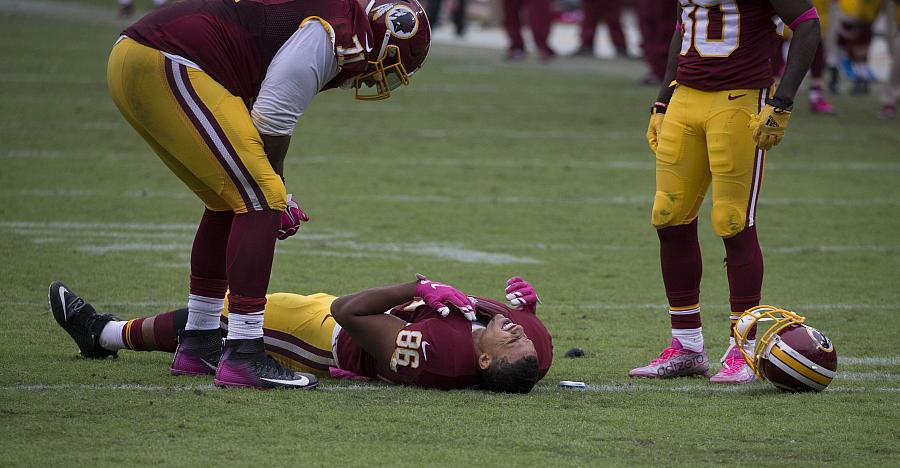Head Shots: Can blood tests and helmet sensors solve the NFL’s concussion problem?

It seems crazy that in 2016 we’re still relying on so much subjective observation by coaches, trainers and medical staff to tell us whether a football player has suffered a concussion, not to mention how to treat the injury.
Football games are a storm of cognitive inputs. From the roar of the fans to the ADD-inducing video screens to all the action on the field of play itself, it’s no surprise that people misjudge situations. Referees miss injurious hits. Coaches don’t notice the warning signs when a player is in the throes of a concussion.
There are two key changes that could be made — and some version of these things should be made — to protect players and to protect the game from losing its essential character. Players throw the ball, catch the ball, run with the ball, and tackle each other. Without the tackling, it might as well be basketball.
First, can we take some of the subjectivity out of the concussion protocol? A test with a reasonable level of accuracy would be a smart start.
There is good reason to believe in the feasibility of a blood test that could give medical staff immediate and more accurate results on the sideline. There are at least two companies currently working on a blood test for concussion symptoms: Quanterix and Banyan Biomarkers. Mike Orcutt at Technology Review wrote about the tests in August 2015:
Given that it is common for physicians to use biomarkers to assess damage in other organs, brain injury biomarkers are overdue, says Patrick Kochanek, a critical care physician and professor at the University of Pittsburgh School of Medicine. He says several of the biomarkers under development ‘give us a decent view of severity,’ and could soon be giving doctors valuable information that can help elucidate the most appropriate course of care.
Can the test results be developed and interpreted quickly enough for a team to make a decision about a player during the game? That remains to be seen. Since Orcutt’s story, Quanterix has decided to take one of the tests it was developing and incorporate some of the components of a test that Banyan was developing, according to an announcement by Quanterix in August 2016. There’s no word, though, on the clinical trials that Orcutt referenced in his piece. A search of ClinicalTrials.gov shows that Banyan has been involved in eight clinical trials recently for head trauma, including five that are complete and one that has been terminated. None of them include any publications. A search of PubMed did not turn up any publications that appear to be related to these trials, either. One hopes that the results are published soon.
Second, can we learn more about the nature of these on-the-field hits?
There had been a movement to deploy football helmets with sensors inside them that would measure the impact of hits. They are used by college football programs but plans for a similar program were abandoned by the NFL in 2015. It was a strange case where the players union and the NFL were on the exact same page on a player safety issue. The cover story the union provided cites concerns about the accuracy of the data and about how individualized medical data for players would be shared with the team and the league. But anyone who knows anything about football knows how carefully the players already are monitored, tested, and measured throughout the season. If they can be ordered to urinate in a cup on demand, they certainly can wear a helmet with sensors. And all tests come with questions of accuracy that need to be addressed.
The real concern seems to be that inaccurate readings would lead to players being sidelined. Games or even careers could essentially be ended by false positives. Or, as some players fear, an accumulation of accurate data could lead team owners to look for ways to get rid of players they feel are becoming a liability. Lloyd Glauberman nicely summarized such concerns for the Huffington Post:
The average salary is around $2 million as of the 2013 season, less than the other professional sports leagues. Moreover, the major jump in salary typically occurs at the time when most players are already out of the league. Hence, the window for football players to make their money is tight. For them, anything that might limit playing time by suggesting they are damaged translates into shorter careers. Sensors, potentially, would do just that.
There has to be a way to make this work, though. Remote sensors are ubiquitous in our homes, offices, and vehicles. We trust them to provide us all kinds of information within a reasonable degree of accuracy. To protect players and protect the game that fans love, we should be able to gather real-time data on hits and translate that into safer play in a way that does not end careers prematurely. Or, conversely, if we find out that players are suffering so much damage in the first two years of their career that they need to stop playing, we need to take stronger measures to deal with the injuries.
How would fans react to even more safety restrictions on the game after so many changes have already been put in place?
I’ll write about that in a future post.
**
Related posts
Head Shots: When sports culture and concussion protocols don’t mix
Concussions in the NFL: A player tells his story

